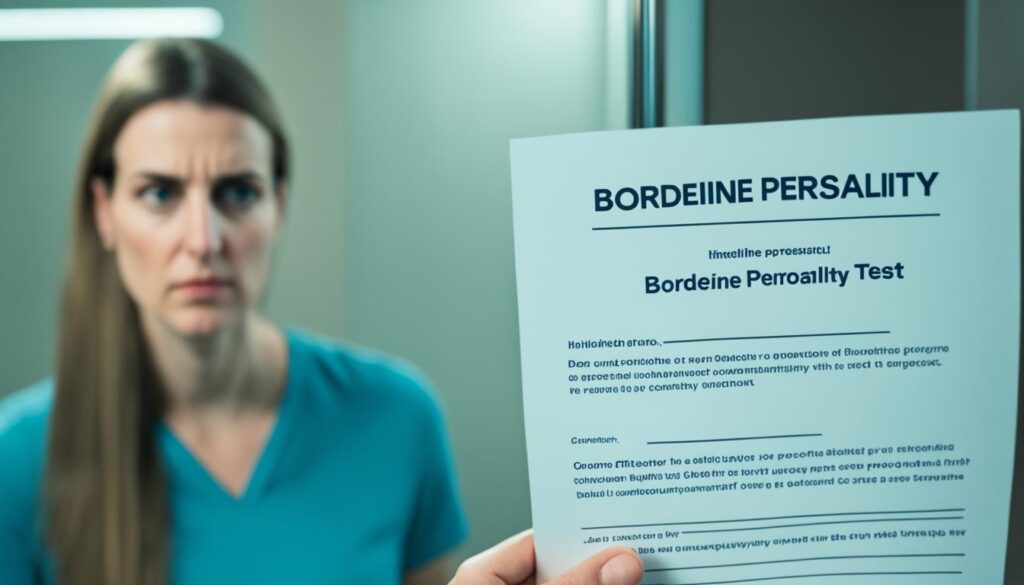Welcome to our thorough guide on tests for borderline personality disorder (BPD). If you think that you or someone you know may be showing signs of BPD, taking a BPD test can offer helpful information and point you in the direction of professional help. This guide will lead you through the steps of taking a BPD quiz, understanding the diagnostic criteria, and the significance of seeking proper medical assessment.
Borderline personality disorder is a cluster B personality disorder that affects a person’s mood, behavior, and self-perception. It can cause emotional instability, difficulty in relationships, impulsivity, anger outbursts, and a distorted self-image. Taking a BPD test can help determine the likelihood of BPD symptoms and the need for professional treatment.
Key Takeaways:
- Taking a BPD test can provide insights into the likelihood of BPD symptoms.
- The McLean Screening Instrument for BPD (MSI-BPD) is a commonly used BPD quiz.
- A BPD quiz is not a definitive diagnosis but can help identify the need for further evaluation.
- Accurate diagnosis requires consultation with a licensed mental health professional.
- Seeking professional help is crucial for developing an effective treatment plan for BPD.
Who Should Take this BPD Quiz?
If you suspect that you may be experiencing symptoms of borderline personality disorder (BPD), it’s essential to take the BPD quiz. BPD can manifest as emotional instability, troubled relationships, impulsivity, anger, and a distorted self-image. If you resonate with these symptoms, it’s crucial to assess whether seeking professional treatment is necessary.
Understanding BPD Symptoms
BPD symptoms can significantly impact daily life and overall well-being. They may include:
- Emotional instability
- Troubled relationships
- Impulsivity
- Anger and irritability
- Distorted self-image
If you relate to these symptoms and feel they are affecting your daily functioning, taking the BPD quiz can provide valuable insights into your condition.
“Taking the BPD quiz can help you determine if seeking professional treatment is necessary.”
Professional Treatment for BPD
Borderline personality disorder requires professional treatment to manage symptoms effectively. This often involves a combination of psychotherapy, medication, and support. Seeking the guidance of a qualified mental health professional is crucial for accurate diagnosis and appropriate treatment planning.
| Benefits of Taking the BPD Quiz | Drawbacks of Self-Diagnosis |
|---|---|
|
|
While the quiz can provide invaluable insights, it’s important to remember that self-diagnosis is not a substitute for professional assessment. A qualified mental health professional can accurately diagnose BPD and guide you through the appropriate treatment process.
Taking the Borderline Personality Disorder Test
Are you wondering if you may have borderline personality disorder (BPD)? Taking the BPD quiz can provide valuable insights into the likelihood of BPD symptoms and the need for further evaluation. The BPD test is based on the DSM-5 diagnostic criteria for BPD and consists of 10 questions.
To take the BPD quiz, simply answer each question with a “Yes” or “No” response. Each “Yes” answer receives 1 point, while each “No” answer receives 0 points. The total score at the end helps determine the likelihood of BPD symptoms present.
Here’s how the scoring works:
- A score of 0-4 indicates unlikely BPD symptoms
- A score of 5-6 suggests possible BPD symptoms
- A score of 7-10 indicates a likely presence of BPD symptoms
It is important to note that the BPD quiz is not a substitute for a professional diagnosis. Only a licensed mental health professional can provide an accurate diagnosis of BPD. However, taking the quiz can help you gauge whether further evaluation and professional treatment for BPD may be necessary.

Example of BPD Quiz Questions:
- Do you experience intense and unstable relationships?
- Do you often fear abandonment or rejection?
- Do you struggle with frequent mood swings?
- Do you engage in impulsive behaviors, such as reckless spending or substance abuse?
- Do you have recurring thoughts of self-harm or suicide?
“The BPD quiz can provide valuable insights into the need for further evaluation and treatment.”
If you suspect you may have BPD or are experiencing symptoms commonly associated with the disorder, consider taking the BPD quiz to get a better understanding of your situation. However, remember that seeking a professional evaluation is crucial for an accurate diagnosis and the development of a comprehensive treatment plan.
Getting an Accurate BPD Diagnosis
When it comes to BPD diagnosis, it’s important to remember that self-diagnosis is not recommended. To obtain an accurate diagnosis, it is necessary to consult a licensed mental health professional. BPD can often be mistaken for other conditions, so seeking the expertise of a qualified practitioner with experience in diagnosing and treating BPD is crucial. A comprehensive assessment, including a psychiatric interview, medical examination, evaluation of symptoms, and review of medical history, is necessary to accurately diagnose BPD. Taking this step towards a professional diagnosis is the first important milestone in developing an effective treatment plan.

Receiving an accurate BPD diagnosis requires the expertise of a mental health professional who specializes in this area. They will conduct a thorough evaluation, considering various factors such as your symptoms, personal history, and any co-occurring conditions. By relying on their expertise and utilizing reputable diagnostic tools, mental health professionals can differentiate BPD from other conditions, ensuring an accurate diagnosis.
Getting an accurate diagnosis is crucial because it lays the foundation for an effective treatment plan. With an accurate diagnosis, mental health professionals can tailor therapy and interventions to address the specific symptoms and challenges associated with BPD. This personalized approach increases the chances of successful symptom management and improved overall well-being.
“An accurate BPD diagnosis is the first step towards developing an effective treatment plan.”
The Role of a Mental Health Professional
A mental health professional, such as a psychiatrist, psychologist, or clinical social worker, is specially trained to diagnose and treat BPD. They have the knowledge and experience needed to differentiate BPD from other mental health conditions and to develop a comprehensive treatment plan tailored to your individual needs.
During the diagnostic process, a mental health professional will conduct a psychiatric interview, asking questions about your symptoms, medical history, and any associated difficulties. They may also collaborate with other healthcare providers, such as primary care physicians, to rule out any physical conditions that may contribute to your symptoms.
By consulting a mental health professional, you can gain a better understanding of your symptoms and receive the appropriate support and treatment necessary to manage BPD effectively.
Understanding BPD Screening Assessments
In order to identify the likelihood of BPD symptoms and determine the need for further evaluation, mental health professionals utilize various BPD screening assessments. These assessments serve as valuable tools in guiding the diagnostic process. While they do not provide a clinical diagnosis, they offer crucial insights to aid in the evaluation process.
The following are common BPD screening assessments:
- McLean Screening Instrument for BPD (MSI-BPD)
- Personality Diagnostic Questionnaire (PDQ-4)
- Structured Clinical Interview for DSM-5 Personality Disorders (SCID-5-PD)
- Zanarini Rating Scale for Borderline Personality Disorder (ZAN-BPD)
These assessments help mental health professionals gather essential information and evaluate the presence of BPD symptoms. It’s important to note that the results of these assessments should be used as a guide and not as a definitive diagnosis.
| Assessment | Purpose |
|---|---|
| McLean Screening Instrument for BPD (MSI-BPD) | To assess the likelihood of BPD symptoms based on DSM-5 criteria |
| Personality Diagnostic Questionnaire (PDQ-4) | To evaluate the presence of personality disorders, including BPD |
| Structured Clinical Interview for DSM-5 Personality Disorders (SCID-5-PD) | To diagnose personality disorders, including BPD, using standardized criteria |
| Zanarini Rating Scale for Borderline Personality Disorder (ZAN-BPD) | To assess and track BPD symptoms and severity |
Note: A table with the four common BPD screening assessments, their purpose, and usage.
Criteria for BPD Diagnosis
The diagnosis of Borderline Personality Disorder (BPD) is based on the criteria outlined in the DSM-5. To receive a BPD diagnosis, an individual must exhibit five or more of the following symptoms:
- Unstable self-image
- Intense anger
- Mood changes
- Recurrent suicidal behavior
- Feelings of emptiness
- Impulsive behavior
- Fear of abandonment
- Identity disturbances
- Paranoia or dissociation
Meeting these criteria is essential for an accurate diagnosis of BPD. It is important to note that a thorough evaluation by a qualified mental health professional is necessary to confirm the diagnosis and rule out other potential causes of the symptoms.

| Criteria | Description |
|---|---|
| Unstable self-image | Difficulty maintaining a consistent sense of self and identity |
| Intense anger | Frequent episodes of intense anger or difficulty controlling anger |
| Mood changes | Fluctuations in mood lasting hours to days |
| Recurrent suicidal behavior | Engaging in self-harming behaviors or having frequent suicidal thoughts |
| Feelings of emptiness | Chronic feelings of emptiness or a lack of purpose |
| Impulsive behavior | Engaging in impulsive actions without considering the consequences |
| Fear of abandonment | An intense fear of being abandoned or rejected |
| Identity disturbances | Confusion or uncertainty about one’s own identity |
| Paranoia or dissociation | Experiencing paranoia or dissociation as a response to stress |
These criteria play a crucial role in identifying BPD and guiding treatment decisions. If you or someone you know is experiencing these symptoms, seeking professional help is essential for a comprehensive evaluation and appropriate management of BPD.
Challenges in Diagnosing BPD
Diagnosing Borderline Personality Disorder (BPD) can be a complex and challenging process due to several factors.
- Co-occurring conditions: BPD often coexists with other mental health conditions such as depression, anxiety, and eating disorders. The presence of these overlapping conditions can complicate the diagnostic process.
- Misdiagnosis: BPD symptoms can be mistaken for other personality disorders, leading to misdiagnosis. It is crucial to differentiate BPD from similar conditions to provide appropriate treatment and support.
- Overlapping symptoms: The symptoms of BPD can overlap with those of other mental health disorders, making it challenging to pinpoint the exact diagnosis. Mental health professionals must carefully evaluate the unique presentation of symptoms to arrive at an accurate diagnosis.
- Stigma: The stigma associated with BPD can result in delayed diagnoses. Mental health professionals may be cautious about labeling someone with BPD due to the potential impact of the diagnosis on the individual’s self-perception and treatment options.
As a result of these challenges, the process of diagnosing BPD often involves multiple appointments and comprehensive evaluations to rule out other possible causes of symptoms.
Impact of Misdiagnosis
Misdiagnosis of BPD can have significant consequences for individuals seeking treatment. Without an accurate diagnosis, individuals may undergo failed attempts at other treatments, prolonging their suffering and delaying access to appropriate interventions.
“Misdiagnosis can lead to ineffective treatment strategies and hinder the individual’s journey towards recovery. It is crucial for mental health professionals to thoroughly assess and consider the possibility of BPD to ensure the best possible care and support for their patients.” – Dr. Jane Smith, Psychiatrist
By addressing the challenges in diagnosing BPD and promoting awareness and understanding among mental health professionals, we can improve the accuracy of diagnoses and ensure that individuals receive the proper care and support they need.
Example of Overlapping Symptoms in BPD and Other Disorders
| Borderline Personality Disorder (BPD) | Depression | Anxiety Disorder |
|---|---|---|
| Emotional instability | Sadness and loss of interest | Excessive worrying and fear |
| Impulsivity | Lack of energy and motivation | Restlessness and irritability |
| Fear of abandonment | Feelings of guilt and worthlessness | Difficulty concentrating and sleeping |

It is crucial for mental health professionals to carefully evaluate the unique presentation of symptoms and consider the context in which they occur to make an accurate diagnosis of BPD.
Can You Self-Diagnose BPD?
When it comes to diagnosing borderline personality disorder (BPD), self-diagnosis is not recommended. While you may recognize recurring patterns in your moods, behaviors, and relationships, it takes a qualified mental health professional to make an accurate diagnosis. BPD symptoms can overlap with other mental health conditions, making it crucial to differentiate and diagnose BPD accurately.
If you suspect that you have BPD, seeking the help of a qualified mental health professional is essential. They have the expertise and training to conduct a comprehensive evaluation and provide you with an official diagnosis. Remember, relying on self-diagnosis can be unreliable and may lead to inaccurate conclusions.
An accurate diagnosis from a qualified professional is important for several reasons:
- Effective treatment: A proper diagnosis allows mental health professionals to develop a personalized treatment plan tailored to your specific needs. BPD treatment often involves various therapeutic interventions, such as dialectical behavior therapy (DBT) or cognitive-behavioral therapy (CBT), to help manage symptoms and promote overall well-being.
- Access to resources: With an official diagnosis, you gain access to valuable resources and support networks specifically designed to assist individuals living with BPD. These resources can provide education, guidance, and assistance in navigating the challenges associated with BPD.
- Validation and self-awareness: Receiving an official diagnosis can help validate your experiences and provide a framework for understanding your struggles. It allows you to gain a deeper understanding of BPD and how it may impact your life, leading to increased self-awareness and the ability to make informed decisions about your mental health.
Remember:
“Seeking the help of a qualified mental health professional is the best course of action to obtain an accurate diagnosis for BPD. They have the expertise and knowledge necessary to differentiate BPD symptoms from other mental health conditions and provide you with the appropriate support and treatment.”

Triggers and Causes of BPD
While the exact causes of Borderline Personality Disorder (BPD) remain unknown, research suggests that a combination of genetic, environmental, and brain chemistry factors contribute to its development. Understanding the triggers and causes of BPD can provide valuable insights into this complex disorder.
Genetics
Genetics play a significant role in the development of BPD. Studies have shown that individuals with a family history of BPD or other mental health disorders have a higher risk of developing the disorder themselves. However, having a parent or family member with BPD does not guarantee that an individual will develop the disorder, as environmental factors also play a crucial role.
Environment
The environment in which a person grows up can have a profound impact on their risk of developing BPD. Childhood trauma, such as physical, emotional, or sexual abuse, neglect, or the loss of a loved one, can increase the likelihood of developing BPD in later life. Additionally, unstable family dynamics, inconsistent parenting, and disrupted attachment patterns may also contribute to the development of the disorder.
Brain Chemistry
Abnormalities in brain chemistry have been observed in individuals with BPD. Neurotransmitters, such as serotonin, dopamine, and norepinephrine, which regulate mood and emotions, may be imbalanced in individuals with BPD. These imbalances can contribute to the emotional instability and impulsive behaviors commonly associated with the disorder.
Triggers for BPD symptoms can vary from person to person and are often influenced by individual experiences and personal vulnerabilities. Stressful life events, relationship issues, emotional instability, and a lack of effective coping strategies can all trigger BPD symptoms. It is important for individuals with BPD to recognize their triggers and work with mental health professionals to develop healthy coping mechanisms to manage these triggers effectively.

| Factors | Description |
|---|---|
| Genetics | Family history of BPD increases the risk of developing the disorder. |
| Environment | Childhood trauma and unstable family dynamics contribute to the development of BPD. |
| Brain Chemistry | Imbalances in neurotransmitters may contribute to emotional instability and impulsive behaviors. |
| Triggers | Stressful life events, relationship issues, and emotional instability can trigger BPD symptoms. |
Understanding these triggers and causes of BPD can help individuals and their loved ones navigate the challenges that come with the disorder. By working closely with mental health professionals and developing effective coping strategies, individuals with BPD can lead fulfilling and meaningful lives.
Living with High Functioning BPD
Living with high functioning Borderline Personality Disorder (BPD), also known as quiet BPD, can present unique challenges. Individuals with high functioning BPD often internalize their thoughts, feelings, and behaviors, making it difficult for others to recognize their struggles. While not an official clinical diagnosis, quiet BPD is considered a subtype of BPD and is characterized by individuals who may hide their symptoms from others.
Living with high functioning BPD requires a deep understanding of one’s own symptoms and self-perception. Despite appearing “high functioning” on the outside, individuals with quiet BPD may experience intense emotional turmoil and a constant fear of abandonment. They may struggle with managing their emotions, have difficulty maintaining stable relationships, and battle with a distorted self-image.
Seeking professional support and treatment is crucial for individuals living with high functioning BPD. Professional guidance can provide invaluable insights into understanding and managing the symptoms of BPD. Therapeutic interventions, such as dialectical behavior therapy (DBT), can help individuals develop healthy coping mechanisms, regulate their emotions, and improve their overall quality of life.
Recognizing Symptoms of High Functioning BPD
The symptoms of high functioning BPD may manifest differently compared to classic BPD presentations. It is essential to be aware of the following symptoms:
- Emotional intensity: Individuals with high functioning BPD may experience intense emotional reactions to everyday events. Small setbacks or perceived rejections can trigger overwhelming feelings of anger, sadness, or shame.
- Self-isolation: People with high functioning BPD often isolate themselves, avoiding social interactions to protect themselves from potential emotional distress or rejection.
- Persistent self-doubt: Individuals with high functioning BPD may struggle with intense self-doubt and chronic feelings of inadequacy. They may be highly critical of themselves, constantly seeking validation from others.
- Self-sabotage: Those with high functioning BPD may engage in self-destructive behaviors, such as substance abuse or self-harm, as a coping mechanism for managing intense emotions.
Benefits of Professional Support
Seeking professional support is essential for individuals with high functioning BPD. The guidance of a mental health professional can help individuals navigate the complexities of their emotions and develop effective coping strategies. Therapy can provide a safe space to explore and address underlying issues, process traumatic experiences, and work towards building healthier relationships.
Living with high functioning BPD can be challenging, but seeking professional support and treatment can help individuals manage their symptoms and lead a fulfilling life.
Remember, you don’t have to navigate this journey alone. Reach out to a mental health professional who specializes in BPD to find the support you need. With the right help and support, individuals with high functioning BPD can learn to navigate their emotions, develop resilience, and cultivate a fulfilling life.

The Limitations of Online Screening
While online screenings can be valuable self-assessment tools to track moods and provide insights into symptom changes, they have limitations when it comes to diagnosing borderline personality disorder (BPD). These screenings can offer a preliminary understanding of one’s mental health, but they cannot replace the expertise and evaluation of a trained medical professional for an accurate diagnosis.
“Online screenings serve as self-assessment tools to track moods and provide insights into symptom changes.”
Consulting with a qualified professional, such as a doctor or mental health professional, is crucial for a comprehensive evaluation and diagnosis. BPD is a complex condition that requires a thorough examination of various factors, including symptoms, personal history, and current mental health status. Only a trained professional can provide the proper assessment and diagnosis necessary for effective treatment.
It’s important to understand that online screenings should not be relied upon as a definitive diagnosis. They can, however, serve as a starting point for recognizing potential symptoms and encouraging individuals to seek professional help.
Limitations of Online Screening for BPD
When considering online screenings for BPD, it’s essential to be aware of their limitations:
- Self-Assessment: Online screenings are self-administered, relying on honest and accurate responses from the individual. However, self-assessments may be subjective and influenced by personal biases or limited self-awareness.
- Diagnostic Accuracy: Online screenings are not a substitute for professional diagnosis. They cannot provide a comprehensive evaluation or consider other potential factors that may contribute to the individual’s symptoms.
- Complexity of BPD: BPD is a complex condition, and its diagnosis requires a comprehensive understanding of the individual’s symptoms, behaviors, and personal history. Online screenings may oversimplify the diagnostic process.
Therefore, while online screenings can be informative for self-reflection and initial awareness, they cannot replace the expertise and personalized evaluation provided by a qualified medical professional.
If you suspect you may have BPD or any other mental health concern, it is recommended to consult with a licensed mental health professional who can provide an accurate diagnosis and guide you towards appropriate treatment options.
The Importance of Accurate BPD Diagnosis
Accurate diagnosis is crucial for individuals with Borderline Personality Disorder (BPD) as it allows mental health professionals to develop a targeted treatment plan tailored to their unique needs. A precise diagnosis enables us to identify specific symptoms and challenges faced by individuals with BPD, paving the way for more effective symptom management and therapeutic intervention.
Through therapy, individuals with BPD can learn valuable coping skills to navigate emotional turbulence, regulate their emotions, and develop healthier relationship patterns. An accurate diagnosis also helps us identify co-occurring conditions, such as anxiety or depression, and address them within the treatment plan.
“An accurate diagnosis is the foundation for effective treatment. It helps us create a roadmap for individuals with BPD to improve their overall well-being.”
With an accurate diagnosis, we can design personalized treatment strategies encompassing evidenced-based therapies such as Dialectical Behavior Therapy (DBT), Cognitive Behavioral Therapy (CBT), and Schema Therapy. These therapeutic approaches focus on enhancing emotional regulation, improving interpersonal skills, and building a strong sense of self. A comprehensive treatment plan empowers individuals to manage their symptoms, find inner balance, and foster meaningful connections with others.

Benefits of Accurate BPD Diagnosis
An accurate BPD diagnosis ensures:
- Targeted therapies: Tailored treatment plans based on specific symptoms and challenges.
- Enhanced symptom management: Effective strategies to regulate emotions and cope with the ups and downs of mood and behavior.
- Improved quality of life: Learning essential skills to build and maintain healthy relationships.
- Identification of co-occurring conditions: Addressing other mental health issues that may accompany BPD.
Example of a Therapeutic Intervention
One example of a therapeutic intervention commonly used in BPD treatment is Dialectical Behavior Therapy (DBT). DBT is a structured therapy that combines individual therapy, group skills training, phone coaching, and therapist consultation meetings. It aims to teach individuals with BPD skills in four key areas: mindfulness, distress tolerance, emotion regulation, and interpersonal effectiveness. By learning these skills, individuals are empowered to effectively manage their emotions, handle relationships, and live fulfilling lives.
| Key Skills Taught in DBT | Benefits |
|---|---|
| Mindfulness | Enhances self-awareness, reduces emotional reactivity, and promotes present moment awareness. |
| Distress Tolerance | Equips individuals with healthy coping strategies for managing distressing or overwhelming situations. |
| Emotion Regulation | Provides tools for identifying, understanding, and effectively managing intense emotions. |
| Interpersonal Effectiveness | Teaches effective communication, assertiveness, and relationship-building skills. |
DBT and other therapeutic interventions, when integrated into a comprehensive treatment plan, can greatly improve the lives of individuals with BPD, enabling them to thrive and develop a strong sense of self.
Overcoming Challenges in BPD Diagnosis
Diagnosing Borderline Personality Disorder (BPD) can be a complex process with several challenges to consider. Co-occurring conditions and overlapping symptoms of other mental health disorders can make it difficult for healthcare providers to accurately diagnose BPD. They may be hesitant to label someone with BPD until other factors have been ruled out, resulting in delayed diagnoses.
Gender and age considerations also play a role in the diagnostic process. BPD may be underdiagnosed in men and overdiagnosed in women. Additionally, adolescents are less likely to receive a BPD diagnosis, which can further complicate their access to appropriate treatment and support.
Despite these challenges, it is crucial to persist in seeking an accurate diagnosis to ensure individuals receive the necessary care and support. BPD is a complex condition that requires comprehensive evaluation and understanding. By working closely with qualified mental health professionals, we can navigate these challenges and overcome barriers to diagnosis.
Quote: “Accurate diagnosis is the cornerstone of effective treatment and management of BPD. By acknowledging the challenges in the diagnostic process, we can work towards improving early identification and providing appropriate interventions.”
Co-occurring Conditions
One of the challenges in diagnosing BPD is identifying and distinguishing it from other co-occurring mental health conditions. BPD often coexists with conditions such as depression, anxiety disorders, substance use disorders, and eating disorders. The overlapping symptoms of these conditions can complicate the diagnostic process, as individuals may present with symptoms common to multiple disorders.
It is important for healthcare providers to conduct a thorough evaluation and consider all possible conditions before arriving at an accurate diagnosis. By understanding the unique presentation of BPD and differentiating it from other co-occurring conditions, we can provide appropriate treatment and support for individuals.
Gender and Age Considerations
BPD diagnosis can be influenced by gender and age factors. Research suggests that BPD may be underdiagnosed in men, as symptoms may manifest differently or be attributed to other conditions. On the other hand, BPD may be overdiagnosed in women due to societal biases and gender stereotypes.
Adolescents with BPD may also face challenges in obtaining a diagnosis. Their presentation of symptoms and difficulties may be mistaken for typical adolescent behavior or other mental health conditions. Early intervention and accurate diagnosis are crucial for adolescents with BPD to receive appropriate treatment.
| Challenges in BPD Diagnosis | Solutions |
|---|---|
| Co-occurring conditions and overlapping symptoms | Thorough evaluation, specialized assessments, and consideration of comprehensive mental health history. |
| Gender biases and age-related differences | Increased awareness, education, and training for healthcare professionals to recognize diverse presentations of BPD. |
| Barriers to adolescent diagnosis | Improved screening tools and early intervention programs tailored to the unique needs of adolescents. |

Despite the challenges in diagnosing BPD, it is crucial to advocate for accurate evaluations and appropriate interventions. By addressing these challenges head-on, we can ensure that individuals with BPD receive the support and treatment they need to manage their condition and improve their quality of life.
Seeking Support for BPD
If you or a loved one is struggling with BPD, know that you don’t have to face it alone. Finding the right support and treatment is essential for managing Borderline Personality Disorder symptoms and improving overall well-being.
One valuable resource available is the Substance Abuse and Mental Health Services Administration (SAMHSA) National Helpline. This helpline can provide information on nearby treatment facilities and support services tailored to individuals with BPD. Their extensive database connects you to local resources specializing in BPD treatment.
Why Seek Support?
Living with BPD can be challenging, but with the right support network, you can navigate the difficulties and find ways to cope with your symptoms effectively. Here are a few reasons to seek support:
- Access to specialized treatment facilities: Treatment facilities that specialize in BPD offer comprehensive programs specifically designed to address the unique challenges faced by individuals with BPD. These programs may include therapy, medication management, and skills training.
- Expert guidance from professionals: Mental health professionals experienced in treating BPD can provide tailored therapies and interventions to help you manage your symptoms. Working with these professionals ensures you receive evidence-based treatment approaches best suited to your needs.
- Validation and understanding: Connecting with others who understand what you’re going through can provide a sense of validation and support. Support groups and individual therapy can offer a safe space to share experiences and learn from others facing similar challenges.
- Improved self-care and well-being: Seeking support enables you to prioritize your mental health and practice self-care. With the right resources and guidance, you’ll develop coping mechanisms, emotional regulation techniques, and strategies for building healthy relationships.
How to Get Support
When seeking support for BPD, start by reaching out to the SAMHSA National Helpline. They can provide guidance on available treatment options and connect you with local resources that suit your needs. This helpline operates 24/7, ensuring support is accessible whenever you need it.
Additionally, consider seeking professional help from licensed therapists or psychiatrists specializing in BPD treatment. They can assess your unique situation, provide a personalized treatment plan, and offer ongoing support tailored to your specific needs.
Remember: You’re Not Alone
BPD can feel overwhelming, but remember that many individuals have successfully managed their symptoms and built fulfilling lives. By seeking support and treatment, you’re taking an important step towards a brighter future.

Conclusion
Getting an accurate BPD diagnosis is crucial for accessing appropriate treatment options and improving quality of life. Living with borderline personality disorder (BPD) can be challenging, but it is a manageable condition with the right treatment plan. By working with a qualified mental health professional, individuals can learn coping strategies, regulate their emotions, and build fulfilling relationships.
Seeking professional help and support is the first step towards living a happier, healthier life with BPD. Treatment options for BPD may include therapy, medication, support groups, and lifestyle changes. With the guidance of a mental health professional, individuals can tailor their treatment plan to their specific needs and goals.
Remember, you are not alone in your journey with BPD. There are resources available to provide support and help you navigate the challenges. Reach out to mental health helplines, support groups, and treatment facilities for assistance. Keep in mind that with the right support and treatment, it is possible to thrive and lead a fulfilling life despite the challenges of BPD.
FAQ
Who should take this BPD quiz?
The BPD quiz is recommended for individuals who suspect they may be experiencing symptoms of borderline personality disorder (BPD). If symptoms such as emotional instability, troubled relationships, impulsivity, anger, and a distorted self-image resonate with you, taking the BPD quiz can help you determine if seeking professional treatment is necessary.
How is the BPD test structured?
The BPD test consists of 10 questions based on the DSM-5 diagnostic criteria for BPD. Each “Yes” answer receives 1 point, and each “No” answer receives 0 points. Scoring helps determine the likelihood of BPD symptoms present. A score of 0-4 indicates unlikely BPD symptoms, 5-6 suggests possible BPD symptoms, and 7-10 indicates a likely presence of BPD symptoms. It is important to note that this quiz is not a substitute for professional diagnosis, but it can provide valuable insights into the need for further evaluation and treatment.
Can I self-diagnose BPD?
No, self-diagnosis of BPD is not recommended. BPD symptoms may overlap with other mental health conditions, and only a licensed mental health professional can accurately diagnose BPD. It is crucial to seek professional help for an official diagnosis.
What are the causes of BPD?
The exact causes of BPD remain unknown. However, several factors, including genetics, environmental factors (such as childhood trauma), abnormal brain structures, and neurotransmitter imbalances, may contribute to the development of BPD. Triggers for BPD symptoms can vary from person to person and may include stressful life events, relationship issues, or emotional instability.
What is high functioning BPD?
High functioning BPD, often referred to as quiet BPD, involves individuals who may hide their symptoms from others. They may internalize their thoughts, feelings, and behaviors, making it difficult for others to recognize their struggles. While not an official clinical diagnosis, quiet BPD is a subtype of BPD. Seeking professional support and treatment can help individuals with high functioning BPD manage their symptoms and lead a fulfilling life.
Can online screenings provide an accurate BPD diagnosis?
No, online screenings are not definitive diagnostic tools for BPD. They can serve as self-assessment tools to track moods and provide insights into symptom changes. However, only a trained medical professional, such as a doctor or mental health professional, can accurately diagnose BPD. It is crucial to consult with a qualified professional for a comprehensive evaluation and diagnosis.
Why is an accurate BPD diagnosis important?
An accurate BPD diagnosis is vital for developing an effective treatment plan. A precise diagnosis allows mental health professionals to tailor therapies and interventions to manage BPD symptoms effectively. Through therapy, individuals with BPD can learn coping skills, emotional regulation techniques, and strategies for building healthy relationships. Seeking an accurate diagnosis is the first step towards achieving symptom management and improving overall well-being.
What are the challenges in diagnosing BPD?
Diagnosing BPD can be challenging as it often co-occurs with other mental health conditions, such as depression, anxiety, and eating disorders. Additionally, BPD can be misdiagnosed as other personality disorders. Overlapping symptoms and the stigma associated with BPD can contribute to delayed diagnoses. Mental health professionals may be cautious about labeling someone with BPD until all other factors have been ruled out, leading to multiple appointments and failed attempts at other treatments.
Where can I seek support for BPD?
If you or a loved one is struggling with BPD, there are resources available for support and treatment. The Substance Abuse and Mental Health Services Administration (SAMHSA) National Helpline can provide information on nearby treatment facilities and support services. Additionally, helpline databases can assist in finding local resources that specialize in BPD treatment. Seeking support is crucial for individuals living with BPD to access the help they need.
How can I improve my quality of life with BPD?
Getting an accurate BPD diagnosis is crucial for accessing appropriate treatment options and improving quality of life. Though the process of diagnosis can be complex and challenging, working with a qualified mental health professional is essential. BPD is a manageable condition, and with the right treatment plan, individuals can learn to cope with symptoms, regulate their emotions, and build fulfilling relationships. Seeking professional help and support is the first step towards living a happier, healthier life with BPD.
Are the symptoms of Avoidant Personality Disorder similar to those of Borderline Personality Disorder?
Yes, the symptoms of Avoidant Personality Disorder can sometimes be similar to those of Borderline Personality Disorder. However, an avoidant personality disorder test can help differentiate between the two. It is important to seek professional help for accurate diagnosis and appropriate treatment for either condition.
Source Links
- https://www.helpguide.org/articles/personality-disorders/borderline-personality-disorder-test.htm
- https://www.verywellhealth.com/borderline-personality-disorder-diagnosis-5101625
- https://psychcentral.com/quizzes/borderline-test
Eugene brings a fresh, dynamic voice to our platform as one of our talented Writers. Specializing in research-driven content, he explores the latest findings in psychology and personal growth, translating them into actionable insights for our readers. Eugene’s work is fueled by a curiosity about what makes us tick and a desire to help others unlock their potential.










